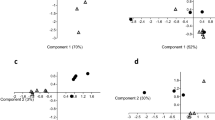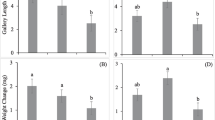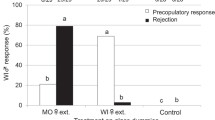Abstract
Research on host selection by bark and wood boring insects has concentrated on flight orientation behavior. Less is known of the factors that govern the steps successive to host landing. Here, we discuss chemical factors involved in host acceptance by bark beetles and a new microassay. Adult males and females of Ips typographus were offered an artificial diet treated with various concentrations of different plant-derived compounds (host terpenes and nonhost compounds) in a no-choice mode. Beetles were tested individually in a glass tube for 4 hr, and the length of feeding was measured and compared to a control (diet with only solvent). The first effect was diet rejection, especially when nonhost compounds were tested at high concentrations. Most compounds reduced feeding, in proportion to concentration. Females were fed more readily than males after addition of both host and nonhost compounds. Diet removal was significantly affected by all the tested factors (sex, compound, dose) as well as by their interactions. With increased concentrations, males were more responsive than females to antifeedants, as all compounds (except juglone) showed clear sex differences of diet consumption. 3-Octanol, 1-hexanol, and a Green Leaf Volatile (GLV)-blend (three C6 alcohols) showed the strongest antifeedant effects, which started at a low dose (0.1%) and had a low Effective Dose 50 (ED50, 0.3–1%). In contrast, host monoterpenes, limonene and α-pinene, inhibited feeding at high doses (10–30%) only with ED50 > 10%. The highest Antifeedant Indexes (AFIs) were shown by verbenone, carvone, and 1-hexanol (0.90–1.00). Both host and nonhost compounds inhibited feeding at some concentration. No significant stimulation of feeding by any host compound at concentrations reported in the literature as optimal were found, with the possible exception of α-pinene at low concentrations in females.




Similar content being viewed by others
References
N. Agelopoulos M. A. Birkett A. J. Hick A. M. Hooper J. A. Pickett E. M. Pow L. E. Smart D. W. M. Smiley L. J. Wadhams C. M. Woodcock (1999) ArticleTitleExploiting semiochemicals in insect control Pestic. Sci. 55 225–235 Occurrence Handle10.1002/(SICI)1096-9063(199903)55:3<225::AID-PS887>3.0.CO;2-7 Occurrence Handle1:CAS:528:DyaK1MXisVWrtrg%3D
K. R. S. Ascher E. Gurevitz S. Renneh N. E. Nemny (1975) ArticleTitleThe penetration of females of the fruit bark beetle Scolytus mediterraneus Eggers into antifeedant-treated twigs in laboratory tests Z. Pflanzenb. Pflanzenschutz 82 378–383
Baier, P., Bader, R., and Rosner, S., 1999. Monoterpene content and monoterpene emission of Norway spruce (Picea abies (L.) Karst.) bark in relation to primary attraction of bark beetles (Col., Scolytidae), pp. 249–259, in F. Lieutier, W. J. Mattson, and M. R. Wagner (eds.). Physiology and Genetics of Tree Phytophagous Interactions. International Symposium, Gujan, France, 31 August–5 September, 1997.
W. D. Bedard (1966) ArticleTitleA ground phloem media for rearing immature bark beetles (Scolytidae) Ann. Entomol. Soc. Am. 59 931–938
J. H. Borden (1997) Disruption of semiochemical-mediated aggregation in bark beetles R. T. Cardé A. K. Minks (Eds) Pheromone Researche: New Directions Chapman and Hall New York 421–438
J. A. Byers (1995) Host-tree chemistry affecting colonization in bark beetles R. T. Cardé W. J. Bell (Eds) Chemical Ecology of Insects, 2 Chapman and Hall New York 154–213
E. Christiansen A. Bakke (1988) The spruce bark beetle of Eurasia A. A. Berryman (Eds) Dynamics of Forest Insect Populations. Patterns, Causes, Implications Plenum Press New York 479–503
J. C. Dickens (1981) ArticleTitleBehavioral and electrophysiological responses of the bark beetle Ips typographus to potential pheromone components Physiol. Entomol. 6 251–261 Occurrence Handle1:CAS:528:DyaL38XotlSqtA%3D%3D
R. W. Doskotch S. K. Chatterji J. W. Peacock (1970) ArticleTitleElm bark derived feeding stimulants for the smaller European elm bark beetle Science 167 380–382 Occurrence Handle1:CAS:528:DyaE3cXptVOqsg%3D%3D
J. S. Elkinton D. L. Wood L. E. Browne (1981) ArticleTitleFeeding and boring behavior of the bark beetle, Ips paraconfusus, in extracts of ponderosa pine phloem J. Chem. Ecol. 7 209–220 Occurrence Handle10.1007/BF00988649
N. Erbilgin K. F. Raffa (2000) ArticleTitleOpposing effects of host monoterpenes on responses by two sympatric species of bark beetles to their aggregation pheromones J. Chem. Ecol. 26 2527–2548 Occurrence Handle10.1023/A:1005532612117 Occurrence Handle1:CAS:528:DC%2BD3cXptV2mt70%3D
C. Everaerts J.-C. Grégoire J. Merlin (1988) The toxicity of Norway spruce monoterpenes to two bark beetle species and their associated W. J. Mattson J. Levieux C. B. Dagan (Eds) Mechanisms of Woody Plant Defenses Against Insects—Search for Pattern Springer Berlin Heidelberg New York 335–344
S. M. Ferkovich M. N. Dale (1971) ArticleTitleNaphthoquinone inhibitors of Periplaneta americana and Scolytus multistriatus feeding: Ultraviolet difference spectra of reactions of juglone, menadione and 1,4-naphthoquinone with amino acids and the indicated mechanism of feeding inhibition Chem.-Biol. Interact. 4 23–30 Occurrence Handle1:CAS:528:DyaE38XlsVOrsQ%3D%3D Occurrence Handle5156334
J. L. Frazier S. Chyb (1995) Use of feeding inhibitors in insect control R. F. Chapman G. DeBore (Eds) Regulatory Mechanisms in Insect Feeding Plenum Press New York 1–42
K. D. Klepzig F. Schlyter (1999) ArticleTitleLaboratory evaluation of plant derived antifeedants against European pine weevil, Hylobius abietis J. Econ. Entomol. 92 644–650 Occurrence Handle1:CAS:528:DyaK1MXnvFOhsr4%3D
E. C. Levy I. Ishaaya E. Gurevitz R. Cooper D. Lavie (1974) ArticleTitleIsolation and identification of host compounds eliciting attraction and bite stimuli in the fruit tree bark beetle, Scolytus mediterraneus J. Agric. Food Chem. 22 376–379 Occurrence Handle10.1021/jf60193a042 Occurrence Handle1:CAS:528:DyaE2cXkvVKks7Y%3D
W. R. McNee P. Bonello A. J. Storer D. L. Wood T. R. Gordon (2003) ArticleTitleFeeding response of Ips paraconfusus to phloem and phloem metabolites of Heterobasidion annosum-inoculated ponderosa pine, Pinus ponderosa J. Chem. Ecol. 29 1183–1202 Occurrence Handle1:CAS:528:DC%2BD3sXjvFyju7Y%3D Occurrence Handle12857030
Q. E. Paynter O. Anderbrant F. Schlyter (1990) ArticleTitleBehavior of male and female spruce bark beetles, Ips typographus, on the bark of host trees J. Insect Behav. 3 529–543
K. F. Raffa (1988) Host orientation behavior of Dendroctonus ponderosae: Integration of token stimuli and host defenses W. J. Mattson J. Levieux C. Bernard-Degan (Eds) Mechanisms of Woody Plant Defenses Against Insects Sringer Berlin Heidelberg New York 369–390
K. F. Raffa A. A. Berryman (1982) ArticleTitleGustatory cues in the orientation of Dendroctonus ponderosae (Coleoptera: Scolytidae) to host trees Can. Entomol. 114 97–104 Occurrence Handle1:CAS:528:DyaL38XitFCks7Y%3D
K. F. Raffa T. W. Phillips S. M. Salom (1993) Strategies and mechanisms of host colonization by bark beetles T. D. Schowalter G. M. Filip (Eds) Beetle–Pathogen Interactions in Conifer Forests Academic Press New York 103–120
J. Reddemann R. Schopf (1996) ArticleTitleThe importance of monoterpenes in the aggregation of the spruce bark beetle Ips typographus (Coleoptera: Scolytidae: Ipinae) Entomol. Gen. 21 69–80
J. A. Rudinsky V. Novak P. Svihra (1971) ArticleTitleAttraction of the bark beetle Ips typographus L. to terpenes and a male produced pheromone Z. Angew. Entomol. 67 179–188
L. Safranyik D. M. Shrimpton H. S. Whitney (1975) An interpretation of the interaction between lodgepole pine, the mountain pine beetle and its associated blue stain fungi in western Canada D. M. Baumgartner (Eds) Management of Lodgepole Pine Ecosystems Washington St. Univ. Press Pullman 406–428
F. Schlyter G. Birgersson (1999) Forest beetles J. Hardie A. K. Minks (Eds) Pheromones of Non-Lepidopteran Insects Associated with Agricultural Plants CAB International Oxford, UK 113–148
F. Schlyter I. Cederholm (1981) ArticleTitleSeparation of the sexes of living spruce bark beetles, Ips typographus (L.) (Coleoptera: Scolytidae) Z. Angew. Entomol. 92 42–47
F. Schlyter G. Birgersson A. Leufvén (1989) ArticleTitleInhibition of attraction to aggregation pheromone by verbenone and ipsenol. Density regulation mechanisms in bark beetle Ips typographus J. Chem. Ecol. 15 2263–2277 Occurrence Handle1:CAS:528:DyaL1MXltlWjtrg%3D
Z. Šimsek ParticleVon E. Führer (1993) ArticleTitleKunstliches Nahr- und Brutmedium fur Ips typographus L. (Col; Scolytidae) J. Appl. Entomol. 116 432–439
V. P. Smelyanets G. I. Vasechko (1973) ArticleTitleThe chemotaxis of Ips typographus (Coleoptera: Ipidae) to terpenoids Zool. Zhurnal 52 1089–1092 Occurrence Handle1:CAS:528:DyaE2cXitlWiug%3D%3D
K. B. Sturgeon (1979) ArticleTitleMonoterpene variation in ponderosa pine xylem resin related to western pine beetle predation Evolution 33 803–814 Occurrence Handle1:CAS:528:DyaL3cXjtlWi
Thomas, H. A., Richmond, J. A., and Bradley, E. L. 1981. Bioassay of pine bark extracts as biting stimulants for the southern pine beetle. USDA Forest Service. Research Note SE-302. 5 pp.
J. H. Visser (1986) ArticleTitleHost odor perception in phytophagous insects Annu. Rev. Entomol. 31 121–144
K. F. Wallin K. F. Raffa (2000) ArticleTitleInfluences of host chemicals and internal physiology on the multiple steps of post-landing host acceptance behaviour of Ips pini (Coleoptera: Scolytidae) Environ. Entomol. 29 442–453 Occurrence Handle1:CAS:528:DC%2BD3cXlvFWgur0%3D
K. F. Wallin K. F. Raffa (2002) ArticleTitlePrior encounters modulate subsequent choices in host acceptance behavior by the bark beetle Ips pini Entomol. Exp. Appl. 103 205–218 Occurrence Handle1:CAS:528:DC%2BD38XovVGhs7k%3D
D. L. Wood (1982) ArticleTitleThe role of pheromones, kairomones, and allomones in the host selection and colonization behavior of bark beetles Annu. Rev. Entomol. 27 411–446 Occurrence Handle1:CAS:528:DyaL38Xot12lsQ%3D%3D
J. H. Zar (1984) Biostatistical Analysis EditionNumber2 Prentice Hall Englewood Cliffs, NJ
Q.-H. Zhang F. Schlyter (2004) ArticleTitleOlfactory recognition and behavioural avoidance of angiosperm nonhost volatiles by conifer-inhabiting bark beetles Agric. For. Entomol. 6 1–20 Occurrence Handle1:CAS:528:DC%2BD2cXnsVeru7s%3D
Q.-H. Zhang F. Schlyter G. Birgersson (2000) ArticleTitleBark volatiles from non-host angiosperm trees of spruce bark beetle, Ips typographus (L.) (Coleoptera: Scolytidae): Chemical and electrophysiological analysis Chemoecology 10 69–80 Occurrence Handle1:CAS:528:DC%2BD3cXlvFygtr4%3D
Acknowledgments
We thank L. Ansebo, M. Tasin, F. Loreto, and S. Larsson for comments on earlier drafts, the Björnstorp Estate for provision of logs, and E. V. Jirle for cutting stems for beetle breeding. The authors are also grateful to the Chemical Ecology Section of the Department of Crop Sciences, SLU (Alnarp, Sweden) for providing facilities and laboratories.
Author information
Authors and Affiliations
Corresponding author
Rights and permissions
About this article
Cite this article
Faccoli, M., Blaženec, M. & Schlyter, F. Feeding Response to Host and Nonhost Compounds by Males and Females of the Spruce Bark Beetle Ips typographus in a Tunneling Microassay. J Chem Ecol 31, 745–759 (2005). https://doi.org/10.1007/s10886-005-3542-z
Received:
Revised:
Accepted:
Published:
Issue Date:
DOI: https://doi.org/10.1007/s10886-005-3542-z




